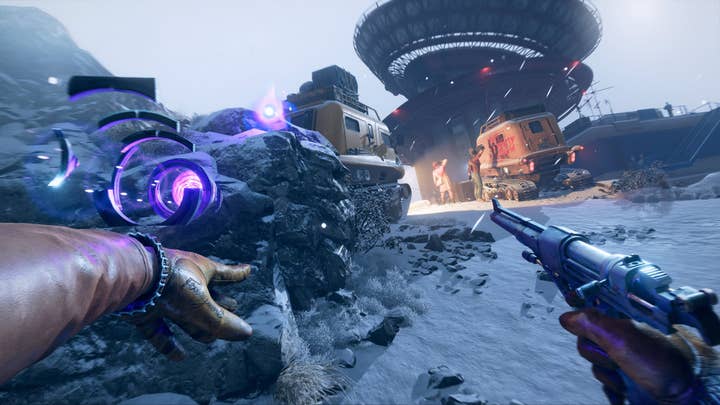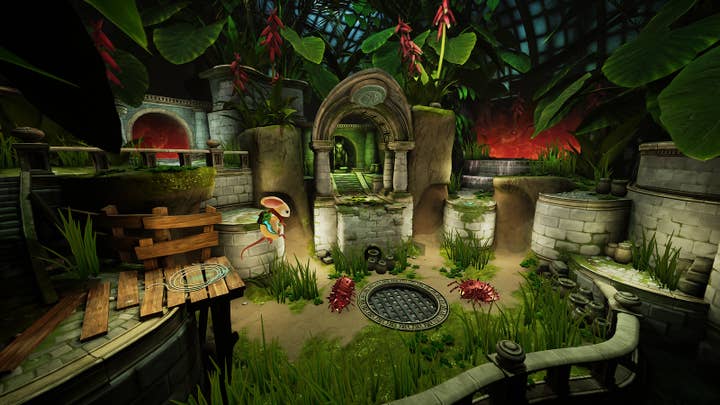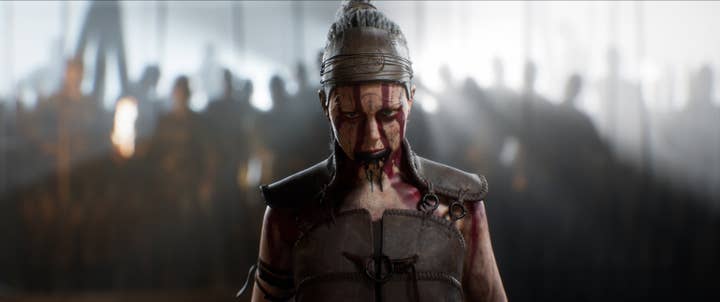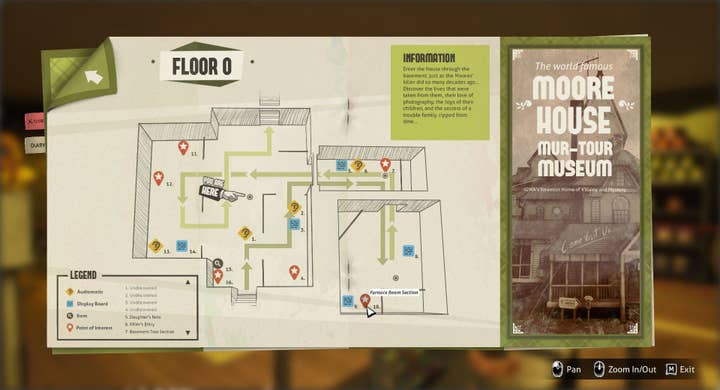How to get a job as a game level designer
The GamesIndustry.biz Academy looks into the various skills required to score a role in level design, a central position in game development
Our guides can help you to find the right path to the games industry job of your dreams. You can read our other in-depth guides on how to get a job in the games industry on this page, covering various areas of expertise.
Level design is one of the key disciplines within game development.
The people who work in this speciality create the world that players explore when spending time within a game. They have to create a playground that is understandable to navigate and that shows off a game's core mechanics, while also making the player feel a certain way.
But it's also a field that varies hugely from studio to studio.
"A common through-line however is [that] a level designer will take the tools, code, art, game systems, story, given to them by the rest of the team and begin the process of turning all of that into an actual game," Arkane Lyon campaign director Dana Nightingale tells the GamesIndustry.biz Academy.
"The player is given tools; how and where can they use them? Characters with AI have been created; what spaces do they inhabit and how can they interact with those spaces? Narrative content is developed; is it integrated into the gameplay space, and if so, how? A level designer's work can be any of these things, and often much more."
Level design is an important field, but one that has a number of different entry points. You can access it via more traditional academic routes, as well as hobbyist ones, making it -- theoretically -- a more accessible sector than more technically-minded areas of game design.
- What education do I need to get a job as a level designer?
- What experience do I need to get a job in level design?
- What qualities and skills do I need to be a level designer?
- What are the common misconceptions about level design?
- What are the career progression opportunities of a level designer?
- Advice for new or aspiring level designers
- Resources

What education do I need to get a job as a level designer?
There are many routes into scoring a job as a level designer. Many of the people we spoke to argue you don't even need a degree specific to this craft, but other fields can give you the expertise you need to be a good level designer.
"A level designer doesn't need to go to school for level design," Nightingale says.
"They can have an education in architecture (like me), or as an engineer, or a writer, or a basic liberal arts degree, or no specific education at all. Teaching yourself how to level design using various free game engines or modding tools is more valuable than a formalised education."
Max Pears, a senior experience designer contractor at Ninja Theory and Tencent, adds he's seen a range of educational levels in this job.
"You can get a degree in game design but you don't need one," he says. "I have seen others join who have come from an architectural background. What you really need is a good portfolio to get a job, not necessarily a degree. However, if you do plan to live abroad, a degree will make that a lot easier."
"If you are trying to find your first job, the best experience is to jump into an editor and just start making maps"
Dana Nightingale, Arkane
While not essential to landing a level design role, there are a number of courses out there that can help you develop the skills you need to land a position in this field.
"Education is still a bit of a prerequisite for getting a job in games and the same goes for level design," freelance level designer Jonathon Wilson says.
"In most cases, it is expected that you will have a relevant degree which would traditionally be some kind of game design degree. As level design continues to become more and more prevalent in the industry there are now more specialised courses that have good LD tracks. The Game Assembly is one example of a more focused course.
"As much as education is important I don't think you necessarily need to have a degree in games now as there are hundreds of online game courses out there now that are quite specialised and have industry accreditation. For example the CGMA: Level Design for games course is a good choice if you're looking to learn about the fundamentals of LD and develop the relevant technical skills required for building levels."
What experience do I need to get a job in level design?
Though there are many educational routes that are good preparation for becoming a level designer, all of that is for nothing if you actually do not have the skills or experience in the craft.
"If you are trying to find your first job, the best experience is to jump into an editor and just start making maps," Nightingale says. "The hardest part -- and often the most impressive -- is finishing. A finished work, even if it's not as ambitious as you'd like, makes you a more interesting candidate."
Beginning to build levels in other games or via modding tools is a solid way of starting your journey into level design. It's a way to build skills, confidence and competence in your craft, but you also need to be able to both listen to and react to feedback.

"Like a lot of game development jobs, real world experience is going to be invaluable," Polyarc designer Doug Burton explains.
"You're going to be able to learn so much and have so many skills and examples to pull from, finding ways to get out there and do the job. Find your favourite game and, if it's moddable or something, try to make some levels and then get some people to playtest. Get that feedback and iterate. You're going to learn a tonne from just doing that a few times. There are some great gems of knowledge you'll get by taking classes or speaking to more experienced developers, but a lot of it won't really stick until you try doing it yourself."
Gaining experience with level design in your own time will also help you build up your portfolio, which is pretty vital to landing a job as a level designer.
"A portfolio shows the levels you have created, showing the overall process your level has gone through," Pears says. "I would also recommend learning about composition, architecture and editors such as Unreal and Unity."
At the end of the day, there isn't really a correct answer as for what experience you need to become a level designer. As creative lead, producer and designer at indie developer CMD Studio, Valentina Chrysostomou says it's entirely possible to pick and choose between more formal education and hobbyist pursuits.
She lists a few avenues she's encountered throughout her career, noting that reality may be a bit more nuanced:

- A university degree (related to game development)
- A level design portfolio
- Small shipped personal solo/team projects (with a focus in level design)
- Previous work or degree useful to level design (but unrelated to game development)
- Previous experience in another field of game development
"While they can all be important and you can combine a few, this will depend on what you can afford to spend time and money on," she says. "You could still get a job without a specific level design degree if you have a strong portfolio for example. Or you can start in a different field in game development and specialise later on in your career, like for example, starting as a game designer or environment artist, and changing to level design.
"It's a competitive market and most people will likely say that you need all the experience and degrees you can get. Personally, I believe in the ability to demonstrate your skills and being able to convince others that you have those skills. How you choose to do that is up to you."

What qualities and skills do I need to be a level designer?
Though level design involves a lot of technical skills, such as knowing your way around various tools or being able to build a space using architectural knowledge, there are also a number of more personal traits that are vital to working in this field.
"I like to think that level design is really about understanding and manipulating players as they move through a space," Burton explains.
"In some ways, it's like being an architect or graphic designer for real-time interactive spaces or experiences. I find that empathy is actually a really useful skill; being able to put yourself in the shoes of different types of players and being able to understand the assumptions they'll make when they enter a space as well as what kind of feelings they'd want to feel from a space, then using that understanding to create spaces and layouts that play off those assumptions to create enjoyable experiences."

Given that level designers are fairly central to the game development process, the ability to be able to work with other people is a pretty important skill to have.
"Level design is a collaborative process, so I cannot overestimate the value of developing your core skills: good communication practices, rigorous documentation, and the ability to give and receive constructive criticism," Nightingale says.
"Even if your technical and design skills are good, it will be difficult to progress in this profession without core skills."
The particular skills you might want to hone also depend wildly on what kind of level design you are looking to move into.
"As usual, this also depends on the role you have in the company," Chrysostomou explains. "A technical level designer might be focusing on level streaming, loading, spawning, triggers, and so on, while a more traditional role might have you oversee the level creation and work with all departments that will have an input regarding that level.
"So to simplify and generalise this a bit, I would say the key skills of a level designer are: soft skills, design and tech."
She details all three key skills she identified:
"I like to think that level design is really about understanding and manipulating players as they move through a space"
Doug Burton, Polyarc
- Soft skills: Know how to approach team members from various departments, how to write requests and documentation, how to give and listen to feedback, how to respect people's time, how to manage and organise your own tasks and time.
- Design: know your pacing and flow, your lore and context, your 3D measurements like scales and distances, know your psychology theories about flow, framing, affordance. Know what makes the gameplay fun in your level and how it fits as a smaller part in the bigger picture, have an understanding of basic art theories. And no matter what you do, play the game and your level often.
- Tech: make sure you know your engine, the tools for creating a level, how to create events within that level via scripting. Even if your focus isn't technical, make sure to have working knowledge of the basics
Chrysostomou really emphasises that she's simplifying important matters.
"But I hope they act as pointers for you to dive deep into them and learn as much as possible," she continues. "Whether you are an aspiring level designer, a junior or a veteran, this is the most important skill. To always be open to learn and evolve."

What are the common misconceptions about level design?
Despite being a fairly prominent part of a video game, level designers aren't as all-powerful or as involved in every single aspect of a project as some might believe.
"Some folks might think that a level gets fully designed and we build all the systems around that design," Burton says. "That may be the case for a few very key levels in a game, like a tutorial or a boss, but I think most spaces are built around the game's constraints; constraints on the position of the camera, the size of the characters, interactive spaces, especially technical constraints like draw distances and object counts.
"Level design can usually start with a high-level idea or goal, and then finding interesting ways to do those goals around all the constraints you have. That's where experience comes in handy; already knowing how to achieve certain goals or feelings within constraints you have already worked with before will save you a lot of time."

There is also a fairly large misconception that level designers not only create the stages that players explore, but are also involved in the more aesthetic aspect of levels.
"When people discuss my maps, I find they often credit me for the work done by the studio's level artists, lighting artists, and environment artists," Nightingale explains. "This will be different from studio to studio, and the size of the team and scope of the project, but largely a level designer will design a map's layout, gameplay flow, craft the challenges, and assemble the underlying logic. The artists are building the models, assembling them into structures and spaces, and setting up the lighting."
Pears adds: "We do not make the game pretty; we make sure the game plays well."
At some studios, level designers might be more heavily involved with the creation of areas though.
"Usually what people think when they hear the words 'level design' is that you create the physical, 3D parts of a level," Chrysostomou explains. "While true, level design can mean so much more.
"For example, you might be in charge of creating the physical 3D space or you might be in charge of creating small scripted encounters within that space. You might be in charge of thinking who are the people that occupy that space and how they live there. You might be working on how the combat encounters will progress through that space or when specific audio cues or special effects will trigger. How does exploration fit in the golden player path and where do you hide all these collectibles?
"Crafting a space is not just the tangible walls that encompass it. Different level design roles will have different requirements so while it's good to narrow down what you prefer to work on, it's always a valid idea to expand your knowledge to all of these areas of level design."

What are the career progression opportunities of a level designer?
As with many aspects of game development, exactly how your career can advance in level design varies wildly from place to place.
Pears says that a rough path would have the entry level for this field be a junior or associate level design position, with the possibility to move into an intermediate or specialist level design role. From there you might be able to move into other, more focused, positions, like technical or combat level designer, depending on what the studio you are working at is like.
After that, your route might split. You can become a lead level designer -- in which you'll be leading a team to help a game director "realise their vision through level design" -- or a principle level designer. The latter is "for those who don't wish to go into a management role but wish to focus more on the craft and making levels," Pears explains.
From being a lead or principle level designer, you are moving into the director tier of game development jobs.

"Now it can be tempting to focus on trying to reach director or lead positions as fast as possible and some will get there quicker than others. The most important thing is to constantly be learning, as the last thing you want to do is reach these positions and not be capable of doing a good job."
Nightingale adds that her personal take on it is that lead level designer should not be seen as a career progression for level designers.
"It's a different job, one a level designer is best suited for, but it shouldn't be the goal of a level designer who wants to move ahead in their career. A studio could, ideally, recognise some level designers as senior or principal, to reward designers for their contributions without leaving management the only option."
In Burton's experience, level design opens up career progression for many parts of game development.
"Level design has a lot of overlap with many parts of game design," he says. "Your career will probably shift a few times along the way. You might do some levels, then switch to systems or cinematics, so your progression will take on more and various game designer responsibilities. Even from associate to senior through principal designer, you'll learn to wear many different hats along the way to get entire games across the finishing line.
"Once a level reaches a point where design is locked so other disciplines can start working on it, a level designer will often switch into more of a support role and be answering questions for other disciplines or helping them implement their work into your levels. It's one of those roles that require you to learn a little bit of everything game development related. You get a lot of experience at collaborating with other disciplines."
Advice for new or aspiring level designers
One of the ways that those interested in level design can learn more about this part of development is by doing it themselves. A lot of titles on PC support mods, while some console games have built-in level makers that consumers can use to explore level design and build up their skills.
Nearly everyone we spoke to for this piece advised to make your own maps and levels to learn more, with Nightingale further saying to look for games with modding tools as it's "easier to get started with all of the game systems and art already in place."
She continues: "When you're ready to move on, grab a freely available game engine with an editor and start making maps. Even if you're in a level design educational program, having made your own maps that are not the result of an assignment will make you stand out."
"Different level design roles will have different requirements so while it's good to narrow down what you prefer to work on"Valentina Chrysostomou, CMD Studio
Pears emphasises that building your levels takes plenty of iterations, adding that "no one gets it right the first time, so keep revisiting and improving."
Meanwhile, Wilson says that aspiring level designers should do thorough research into what the field actually involves.
"Make sure that you fully understand what level design involves so you have a good idea of what you would be doing in that role," he says. "There are many different design roles available now and while there will be some crossover each has its own set of responsibilities."
Resources
- BOOKS
- "101 Things I Learned in Architecture School" by Matthew Frederick
- "101 things I learned in Urban Design School" by Matthew Frederick
- "Let's Design: Exploration" by Max Pears
- "Let's Design: Combat" by Max Pears
- ONLINE
- Level Design Podcast
- Level Design Lobby Podcast
- GDC YouTube Channel, including Interior Design and Environment Art: Mastering Space and Mastering Place by Capy Games' Dan Cox and Environment Design as Spatial Cinematography: Theory and Practice by Rockstar North's Miriam Bellard
- Game Makers Notebook
- Level Design, In Pursuit of Better Levels, by Alex K
- Level Design Compendium, by Vicente Quesada
- Game Design Resources
- The Game Assembly
- The CGMA: Level Design for Games
More GamesIndustry.biz Academy guides to Working in Games
Our guides to working in games cover everything from how to get a job in the industry to how to avoid burnout:

